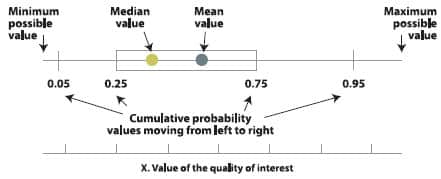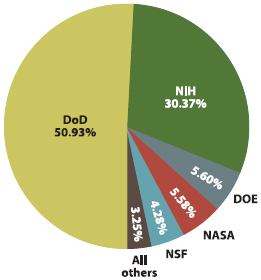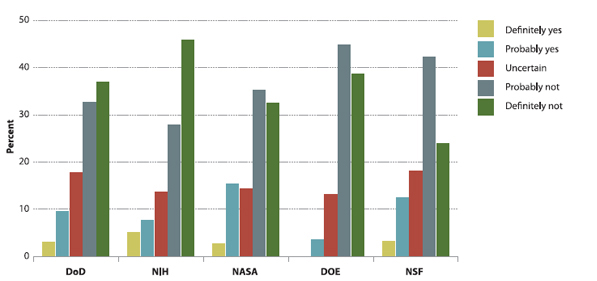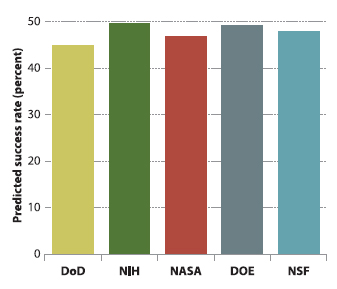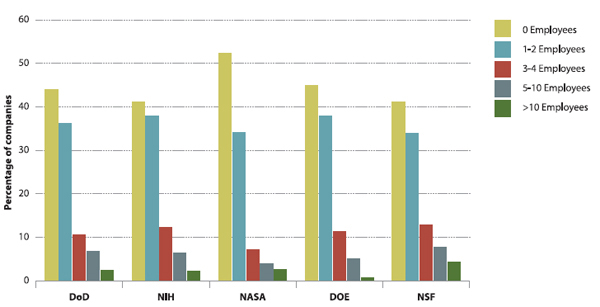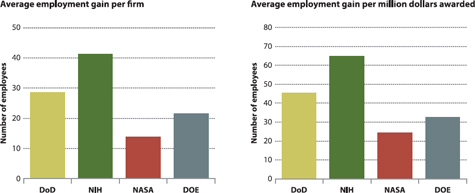National education standards
Martin West’s “Global Lessons for Improving U.S. Education” ( Issues, Spring 2012) reaffirms the importance of developing and implementing rigorous standards and transparent data-driven accountability in our schools.
The extent of students’ capabilities carries an immense economic and social impact for America’s families, communities, and states. As the United States continues to rank below the world’s high-performing nations in core subjects, we must transform our education system to ensure that every student gains the power of knowledge.
We cannot fund our way to the top. West points out that the United States achieves second-rate results while spending significantly more per student than higher-performing countries. Our nation has the resources, financial and human, to host the greatest education system in the world. And that is what our students deserve: an education system designed to equip every child to achieve their God-given potential.
As West notes, education reform should improve the quality of education available rather than merely increase the quantity that students consume. To accomplish this, complete transformation is needed.
We need higher standards. West reports that by age 15, the average U.S. student is a year behind the average student in six countries in math. Recognizing the need for change, state leaders developed new benchmarks focused on preparing today’s students to thrive in the 21st-century workforce. Thanks to those efforts, most states have adopted the Common Core State Standards, and beginning in the 2014–2015 school year, math skills and concepts will be more focused across the nation. The first step, adopting the new standards, has largely been accomplished. The second step, implementing these standards and preparing teachers and school infrastructure, is critical.
We must hold schools accountable for the learning of each and every student. Transparent data-driven accountability that recognizes both progress and performance is necessary. This provides leaders, communities, and parents with a clear understanding of their school’s true state of education. Without assessments to compare students’ achievements against the standard of knowledge and skills they need to be successful, teachers, school leaders, and parents are ill-equipped to help each child learn.
We must also hold all students to high expectations and end the damaging practice of social promotion. Too many students leave high school only to face college remediation. Worse yet, many students never graduate because they become bored or fall behind.
A state-led movement to fundamentally shift education policy toward student learning and cognitive development is sweeping the nation. In the past two years, nearly half the states have adopted reforms to improve student achievement and transform education for their students. This is exciting, but we must remember that successful education reform is a process, not an event.
Only after lawmakers, communities, and educators recognize the urgency of the matter and commit to a longterm investment in our students’ future will our states unleash an unprecedented flood of human potential.
JEB BUSH
[email protected]
The author was governor of Florida from 1999 to 2007 and chairs the Foundation for Excellence in Education.
Martin West builds a careful case that our nation’s productivity is closely tied to our educational outcomes. Although it is true, as West notes, that global academic competition is not a zero-sum game, the failure of our education system is profound. Even in our usual area of competitive advantage, higher education, we face rapid growth from competing nations. In K-12 schools, moreover, the situation is increasingly bleak.
West flags some consequences, including increased gross domestic product, that are achievable with better education outcomes. I think we can state the risks even more bluntly, and here I add at least two. As co-chair with Condoleeza Rice of the Council on Foreign Relations Independent Task Force on Education, we identified a critical national security risk produced by the inability to recruit sufficiently educated troops. More broadly, as students drop out of high school in droves and cannot earn a living wage, we begin to experience a threat to U.S. unity and cohesion, and consequently an erosion of our social fabric.
These conditions require immediate and drastic action. We can surely learn from international policy, but there are some steps we must take to address our unique system woes. Our Council report identified three paths. First, common core standards, to be voluntarily adopted by the states, must raise the game and include subjects critical to national security. Currently, most states set the bar too low, and all too often a high-school diploma is not worth the paper on which it is printed. Second, we must see an expansion of choice in public education, allowing all parents to choose their child’s school regardless of income level, leveraging the uniquely American system of competition and innovation. Finally, we need a national security audit to hold policymakers accountable and to deepen public knowledge of the risks to our security apparatus that exist without high-quality education. Although we can continue to document our nation’s dismal education performance on standardized tests, until this issue becomes a national priority of great urgency our students will continue to fall behind their global peers.
JOEL KLEIN
News Corporation
New York, New York
Martin West has written a very insightful piece about comparisons of U.S. student performance with that of students in other leading countries and the relationship of student achievement to countries’ economic competitiveness. I have little quarrel with his analysis as far as it goes. His concluding policy lessons are important, although I would substitute a discussion of school choice in the United States for his “privateschool competition” notion. U.S. private schools operate very differently from those in other nations, and as he notes, they are more like U.S. charter schools.
My problems with the West piece are three major differences among high-performing countries and the United States that he never mentions: The unique U.S. decentralized system of K-12 education governance; the grossly inequitable ways that schools are funded; and the lack of support for social services, especially preschool education and health care, which children in most leading countries receive routinely.
No other advanced country is as decentralized in governing education as the United States, with its system of local, state, and federal funding and responsibilities organized among 15,000 school districts with mostly elected school boards, 5,000 charter schools, and state and federal regulators. Many of the high-performing nations were not always so successful educationally or economically. Ye t these countries broke with their pasts, embraced the national redesign of their now centrally operated school systems, and instituted fairer funding schemes. And they did this relatively quickly, over two or three decades. Radical change in the design of public education has never taken place in the United States.
With regard to school finance, in the United States, schools with large concentrations of low-income students usually receive less funding than other schools with fewer low-income students in their districts. And districts with low property wealth in most states have fewer resources unless a state chooses to pick up a significant share of education costs. The federal government pays for at best 10% of education costs and barely makes a dent in differences in education spending among states even when adjusted for cost differences. Other advanced countries fund their schools more centrally and allocate funds to schools based on student needs. As Andreas Schleicher of the Organisation for Economic Cooperation and Development has pointed out, “It is noteworthy that spending patterns in many of the world’s successful education systems are markedly different from the U.S. These countries invest the money where the challenges are greatest rather than making resources contingent on the economic context of the local communities in which schools are located, and they put in place incentives and support systems that attract the most talented school teachers to the most difficult classrooms.” (testimony March, 9, 2010, before the Senate Health, Education, Labor, and Pensions Committee; http://help.senate.gov/imo/media/doc/Schleicher.pdf).
Of course monetary investments alone in the United States and abroad don’t track school achievement scores. As an advocate for fiscal equity, I’m constantly challenged about high spending in several low-achieving districts; for example, Newark, New Jersey. However, no other successful country provides less funding for lowincome or primary-language learners than for more affluent and native language speakers. But the United States does. What we need is a state-based system of school funding based on student need, with an accompanying accountability system for results and productivity.
Finally, most advanced countries make sure all young children have access to high-quality early childhood programs. And they guarantee necessary health care. In the United States, only 66% of low-income four-year-olds attend preschool, whereas 90% of more affluent students do.
CYNTHIA G. (CINDY) BROWN
Vice President for Education Policy
Center for American Progress
Washington, DC
[email protected]
An incomplete view of adolescence
On a recent trip to the Pocono Mountains in central Pennsylvania, I found myself perusing a book at our small bed-and-breakfast about the lives of Pennsylvania coal miners in the 19th century. On the cover was an old daguerreotype of a formally dressed and solemn-looking pair, decked out with flowers and holding hands. The caption revealed that the couple had just been married. The bridegroom was 16 years old and the bride barely 14.
Laurence Steinberg’s “Should the Science of Adolescent Brain Development Inform Public Policy? (Issues, Spring 2012) put me in mind of this photo. It should not be forgotten that in our country today, the study of adolescent behavior is almost exclusively the study of the behavior of our own adolescents. Although psychologists routinely attend to the spectrum of conduct across prevailing social conditions, they are much less sensitive to the social realities of the past. The reasons for this are not hard to fathom. The teens who lived in prior centuries are dead. Their parents, mentors, and teachers are too. None can be interviewed and their brains cannot be scanned. At most we have historical or literary records of their thoughts and doings. Almost always this qualifies as anecdote, not data.
Nonetheless, we have reason to believe that the past was a radically different place for the young. As the picture of the solemn newlyweds suggests, teens in previous centuries were often expected to and in fact did accede to weighty responsibilities at a relatively early age. Courtiers, military men, and future leaders emerged in their midteens and engaged in practical endeavors we now associate with adulthood. Males routinely took on work, community, and political roles and were charged with family support. Girls married early and were immediately treated as women. For most of human history, teen moms have been the norm rather than the exception. By and large, these young men and women had no choice. The signature institutions of today’s prolonged adolescence, and one might say prolonged immaturity, simply did not exist. For the vast majority, book learning and formal education were simply unavailable. In this radically different cultural and institutional setting, teens were expected to behave with far greater maturity and to take on adult roles. In response to those expectations, many (indeed almost all) actually did.
Why does this matter? Scientists who study human development should not lose sight of the phenomenon of range restriction; that is, the failure to canvass all the possible environmental and cultural influences that bear on human behavior. Range restriction is, of course, a notorious source of distortion in our understanding of human nature. But that distortion is not just cross-sectional; it is longitudinal as well. Because psychosocial research today virtually ignores history, its picture of development is necessarily incomplete. In noting that teens tend to be more impulsive, shortsighted, risk-seeking, and self-centered, Steinberg nods to past differences but does not give them nearly enough weight. By assigning few serious responsibilities to teens and demanding relatively little of them, we permit certain tendencies to emerge and even encourage them to thrive. The behaviors we currently associate with adolescence are, in effect, a historical luxury, enabled by an affluent, individualistic, self-expressive, and permissive culture that represents a restricted range of possibilities. Psychologists and brain scientists should never forget that the past is a foreign country. The adolescence we observe, and that we are now actively seeking to correlate with neuroscientific findings, is not the way it has to be.
AMY L. WAX
Robert Mundheim Professor of Law
University of Pennsylvania Law School
Philadelphia, Pennsylvania
[email protected]
California: Radical carbon cuts needed?
In “The 80% Solution: Radical Carbon Emission Cuts for California” (Issues, Spring 2012), Jane C. S. Long and Jeffery Greenblatt summarize an admirable analysis by the California Council on Science and Technology (CCST) on the technical feasibility of California’s bold target to cut greenhouse gases to 80% below 1990 levels by 2050. The full report merits careful study, particularly the spreadsheet that lays out the analysis and lets you work through alternative assumptions.
The study’s most important insight is one that is easy to overlook or misinterpret: the demonstration that it is feasible to cut California emissions by 60% using only available and nearavailable technologies. Granted this falls short of the 80% target, but it is still an enormous reduction, particularly considering projected population and economic growth through 2050. The result is a powerful demonstration of just how much can be achieved with technologies that are already commercial or nearly so. More distant advances promise even larger reductions, of course, and merit serious pursuit. Indeed, the authors find that further advances are needed for the last 20% of the target. But this result forcefully rebuts the popular delusion that we can limit climate change risks by ignoring near-term technologies and the incentives and institutional changes needed to deploy them, relying instead on research that chases big, distant, breakthrough innovations.
The study’s projected gains are probably conservative because its mandate was limited to technical feasibility. This required the participants to finesse several key issues of economics and policy related to the cost of technologies. In separating near-available from moredistant technologies, they used only a rough and implicit cost threshold, excluding options judged likely to remain “excessively costly” through 2050. But of the technologies they judged feasible, many will cost more than the highemitting alternatives they supplant. Achieving the rapid deployment on which their results depend will thus require policy-generated incentives that favor low- and nonemitting technologies over conventional high-emitting ones, including economy-wide measures (for example, emission taxes or tradable emission-permit systems) that put a price on emissions.
Such policies have two effects. On the supply side, they give investors incentives to develop and deploy emission-cutting technologies. At the same time, they affect demand by raising the price of fossil energy and the products using it. Of these two effects, the first figures in the CCST analysis, but only implicitly. Its actual effect on emissions could be more or less than their “feasible” reduction, depending on whether the incentives enacted lie above or below the rough cost cutoff marking their boundary of feasible technologies. The second, demand-side effect will also reduce emissions, as consumers and other economic actors adjust their decisions to the higher cost of emissionintensive energy. But the CCST feasibility analysis did not consider such behavioral adjustments, because they were outside their mandate. These thus represent an additional consequence of the policy-generated incentives needed to motivate the innovation and technology deployment on which the CCST analysis focuses. Although these pose significant social, economic, and political challenges, mainly related to their distributive effects, they represent an additional environmental benefit of well-designed policy. They also provide much of the answer to the question the authors appropriately pose, of how to avoid losing the gains from technological progress through behavioral rebounds.
EDWARD A. PARSON
Joseph L. Sax Collegiate Professor of Law
Professor of Natural Resources and Environment
University of Michigan
Ann Arbor, Michigan
[email protected]
Jane C. S. Long and Jeffery Greenblatt observe that California’s plan for radical decarbonization of its economy is unachievable, even with massive social and technological reengineering. I suggest that the decarbonization agenda is also unwise, illiberal, and regressive.
First, let’s be clear: There is very little environmental benefit to be had in California’s pursuit of decarbonization. California produces about 1% of global greenhouse gas emissions. Even if California cut its emissions to zero, there would be no significant impact on global average temperatures.
But there will most certainly be costs. As I document in The Myth of Green Energy Jobs: The European Experience, we know what happens when governments pursue policies that raise the costs of energy and compromise competitive energy markets: Net jobs are lost, economies contract, industry flees, individuals are pushed into energy poverty, and corruption blooms. The effects of such policies fall most heavily on society’s most vulnerable populations: the elderly, the poor, and the infirm.
Californians should know this. As demographer Joel Kotkin has documented, California is in sharp decline, economically and socially, partly if not largely because of its pursuit of draconian environmental regulations. Pursuing green-at-all-cost policies has produced a highly regressive two-tiered economy that increasingly consists of the ultrawealthy and a poorly paid serving class. This is exactly the opposite of what California’s “progressive” politics promised.
Yes, California has a beautiful environment that must be protected, but it must be protected pragmatically in a way that balances human values with environmental values; in a way that is compatible with a flourishing society of people who are empowered socially, politically, and economically. Chasing after radical decarbonization is not a part of that picture.
KENNETH P. GREEN
Resident Scholar
American Enterprise Institute
Washington, DC
[email protected]
Better STEM for all
Robert D. Atkinson’s proposals for a new science, technology, engineering, and mathematics (STEM) education reform strategy, if enacted, would shortchange students and imperil our nation’s economic recovery (“Why the Current Education Reform Strategy Won’t Work,” Issues, Spring 2012). His arguments reflect a selective and myopic reading of the data and seem to ignore completely significant developments in research on student learning and the economy. Atkinson suggests that we move from some STEM for all to all STEM for some. As the executive director of Project Kaleidoscope, a national organization that has worked on improving STEM education in colleges and universities for more than two decades, I recommend that readers consider a broader set of research studies that are guiding the STEM reform movement. This economic and educational research makes clear that we need more widespread adoption of engaging teaching and learning strategies so that all students will graduate with a better understanding of our scienceand technology-driven world. These strategies have been shown to motivate students to stay in STEM and help them achieve higher levels of proficiency, particularly students who are traditionally underrepresented in higher education and especially in STEM fields.
Educational, policy, and business leaders from many sectors have been calling for years for a multifaceted reform strategy to improve STEM learning outcomes for all students and, at the same time, increase the numbers of students graduating with STEM degrees. It isn’t an either/or proposition. Atkinson focuses exclusively on what he calls STEM jobs. He seems to have missed, however, the findings of the recent study from the Georgetown University Center on Education and the Workforce. That study’s authors suggest that we do face a shortage of workers with high-level STEM degrees, but as they put it, “the deeper problem is a broader scarcity of workers with basic STEM competencies across the entire economy.” In fact, they note, “the demand for workers in STEM-related occupations is increasing at every education level. The STEM supply problem goes beyond the need for more professional scientists, engineer, and mathematicians. We also need more qualified technicians and skilled STEM workers in Advanced Manufacturing, Utilities and Transportation, Mining, and other technology-driven industries.”
Atkinson ignores this and other data that suggest that employers want greater focus on STEM learning for aspiring STEM students and others. In a national survey of employers commissioned by the Association of American Colleges and Universities in 2009, 70% of business leaders said they want colleges and universities to place more emphasis on science and technology for all college students. Moreover, STEM learning is essential for increasing our nation’s civic capacity as well. Atkinson handily ignores the ways in which scientific and quantitative literacy are essential for responsible citizenship in a world as steeped in technology and scientific innovation as our own.
Atkinson is also mistaken about what it takes to become a scientist or engineer. He notes that “being a scientist or engineer requires above-average intelligence.” Even if we accept this premise, there is abundant evidence that many students with high levels of intelligence lack access to programs that support effective STEM learning. The research on learning has shown that students from a variety of backgrounds are capable of excelling when given the opportunity. Our best future doctors and engineers may be at the poorest schools in our nation, and without an approach of some STEM for all, they may never emerge to cure cancer or create better technological solutions to pressing national and global challenges.
Atkinson’s proposal to focus resources on more STEM for fewer students would perpetuate the current state of exclusivity and favor those who already have access to strong preparation. We agree with his assertion that “society currently does a poor job in high school and college of helping those students get all the way to a STEM degree.” But we need to also draw in those students who may have an aptitude for STEM but are not already in the pipeline. This means we must focus on students from minority groups traditionally underserved by the K-12 school systems and by colleges and universities.
SUSAN ELROD
Executive Director
Project Kaleidoscope
Association of American Colleges & Universities
Washington, DC
[email protected]
Robert D. Atkinson’s essay is timely and important. There is a broad consensus that the economic success of the United States depends on effective education in STEM. The consensus extends to top business leaders, as shown by the 2005 Business Roundtable report Tapping America’s Potential: The Education for Innovation Initiative, and to national politicians and university presidents, as shown by the 2005 Council on Competitiveness report Innovate America. The National Science Foundation, one of the largest sources of research funding for science and engineering research, considers STEM education to be a core part of its mission.
Atkinson’s article ranges over many topics, but his main point is that we should devote most of our STEM education resources to a small group of talented students who have demonstrated the potential and motivation to excel at STEM. And although he is not explicit about this, he also seems to believe that we should stop teaching STEM to the majority of students who do not have such aptitude or interest or at least, that doing so is not a compelling national interest.
Atkinson’s article is well reasoned and grounded in solid data, but I would modify his argument somewhat. I agree that the main reason that talented college students leave STEM majors is because of the way those disciplines are taught: in large lecture classes focused on memorization of material to prepare for midterm and final exams. However, I worry that it may be too simplistic to attribute this to poor teaching as Atkinson does. Rather, the problem is that college STEM teaching is often not based on findings from learning sciences. From learning-sciences research, we know that deeper learning results from active, project-based learning, as students engage in solving real-world problems in teams with other learners. Atkinson mentions the Olin College of Engineering, although he doesn’t note that they are one of the leaders in transforming curricula away from lectures and toward these learning-sciences–based models. Better teachers cannot fix the broken model of lecture-based instruction; we need a radical transformation toward research-based teaching.
I agree with Atkinson that one goal of national education policy should be to provide the fuel needed to power a science- and technology-driven U.S. economy, and to achieve this goal, one could reasonably argue for Atkinson’s all STEM for some framework. Atkinson points out that only 5% of jobs are STEM jobs, and that more than 70% of these jobs are in computer science and engineering. But I would also argue for a second goal of national educational policy: to prepare an educated citizenry to vote intelligently on STEM issues. On average, U.S. citizens are woefully unprepared to understand issues such as global climate change, evolution by natural selection, floridation of drinking water, and immunization of children. A powerful nation needs both some STEM for all, and all STEM for some.
KEITH SAWYER
Associate Professor
Department of Education
Washington University
St. Louis, Missouri
[email protected]
I read Robert Atkinson’s article with great interest. His catchy contrast of “STEM for all” with “all STEM for some” provokes the reader and challenges some of our most popular beliefs about what the nation needs to do to increase STEM innovation.
We need both engineers and professional piano players, but by relying on the strained analogy of music education and STEM education, Atkinson risks losing his audience. The valuable core of his argument may be dismissed by people who hold and intensely advance many of the ideas he identifies as myths: In a globalized society, all students need to be job-ready in STEM, K-12 STEM teachers need to be paid more, and students need to be convinced STEM is “cool.” Because space does not permit me to challenge or applaud Atkinson’s arguments fully, I have selected three points for commentary.
IN THE SAME WAY THAT OUR SOCIETY IS THE RICHER FOR DEVELOPING A CITIZENRY THAT APPRECIATES GOOD MUSIC WHETHER OR NOT EACH PERSON DEVELOPS INTO A PROFESSIONAL JAZZ MUSICIAN, OUR SOCIETY IS THE RICHER FOR CULTIVATING THE SEEDBED OF STEM LITERACY.
First, innovations that lead to largescale improvements in our standard of living grow out of the STEM disciplines. In this regard, Atkinson is quite right. As a nation, we have not allocated sufficient resources to the development of high-level STEM talents, which are the source of these desirable innovations. Although U. S. graduate schools with their labs and research teams are the best in the world at cultivating STEM talent among students who have the interests and the abilities to profit from them, it is a long wait and a long pipeline to that experience. Atkinson is understandably impatient.
I agree with Atkinson’s argument that we have neglected the students who have the interest and ability to become innovative scientists, engineers, mathematicians, and inventors. Our federal investment in them, the tiny Jacob K. Javits Gifted and Talented Students Program, was zeroed out in the latest federal budget. Allocating resources to talented children and adolescents has always been a tough policy sell. With the exception of the postSputnik panic, the nation has not directed sufficient funds to the development of STEM talent during the precollegiate years. Atkinson’s proposal that more specialized STEM high schools be established is one useful strategy and appears to have garnered current political support at the federal and state levels. We do have specialized STEM high schools now, and we appear to be on the road to establishing more of them. While we are at it, we should fund them more generously, too. Now, however, how are we to encourage students who wish to take on a challenging STEM course of study at the high school or undergraduate collegiate levels? STEM innovators do not spring fully formed from Zeus’s forehead, ready at age four to major in physics.
Second, I therefore disagree with Atkinson’s apparent assumption that STEM education is not necessary for all children and adolescents. Here’s why. Atkinson is quite correct when he identifies interest, ability, and motivation to become STEM professionals as important psychological variables. We know through the study of talent development in many disciplines (including the STEM disciplines of science and mathematics in particular) and through intervention studies in schools that children’s interests appear early and through exposure to opportunity. Cultivation of STEM talent at the elementary grade levels and subsequently through the full K-12 schooling experience is the nursery out of which STEM innovators grow. Not to devote resources through teacher preparation in STEM at the primary and elementary grade levels is shortsighted. Not to devote resources to teacher preparation for the identification of STEM interests and talents in young children is shortsighted. In general, our educational research community and our educational professionals are abundantly shortsighted about talent development; we do not need more of the perspective that bright and motivated youngsters can make it on their own through benign policy neglect or minimal educational services. I applaud Atkinson’s willingness to place the uncomfortable elephants directly in the center of the room. He simply needs to allow them to be in the room earlier in the K-12 educational trajectory.
Third, Atkinson relies on economic arguments to advance his perspective. According to his argument, we cannot afford to take the STEM for all approach, so we must retrench and take the all STEM for some approach. Sadly, this false resource allocation dichotomy, too, is shortsighted. Perhaps a clarification of our national goals for STEM might assist us in disentangling the economic arguments. We must have twin goals for STEM. Other nations do, and it appears to be working for them. Surely we can follow suit. The twin goals are, indeed, STEM innovation and STEM literacy.
In a recent report from the National Science Board, Preparing the Next Generation of STEM Innovators: Identifying and Developing Our Nation’s Human Capital, convincing arguments buttressed by research and policy recommendations were put forth. The development of greater numbers of specialized STEM programs with research support was recommended; increasing captivating and challenging science experiences for young children guided by confident teachers was recommended, too. These actions provide the nurseries out of which the next generation of STEM innovators grows.
In addition to high-level STEM innovators, our nation does need a STEM-literate citizenry. We have citizens who fear fluoride in the water, are duped by the misleading use of statistics in political debates, and fail to support the acquisition of tax revenue to replace bridges ready to collapse from age. STEM literacy is necessary if our nation wishes to engage in enlightened political discourse, improve our standard of living, and be willing to vote for the enlightened tax policies that make economic investment in education—the kind of education that fosters STEM talent development—possible. In the same way that our society is the richer for developing a citizenry that appreciates good music whether or not each person develops into a professional jazz musician, our society is the richer for cultivating the seedbed of STEM literacy. The foundation of STEM literacy sets our future STEM innovators on the pathway to talent development and advanced achievement in and passion for “doing” science, technology, engineering, and mathematics.
ANN ROBINSON
Professor and Director
Jodie Mahony Center
University of Arkansas at Little Rock
Past President, National Association for Gifted Children
[email protected]
The article by Robert D. Atkinson should be read together with the one by Brian Bosworth on “Expanding Certificate Programs” in the Fall 2011 Issues. They both tell the same story: Instead of a one-size-fits-all education path from kindergarten through college, we need to identify at an early stage each child’s inclination and provide an appropriate education path toward his/her goal. For those inclined toward math and science, provide academic challenges to stimulate their interest. Children with manual skills may pursue a certificate program in a selected trade. Others with an inclination toward the arts could be rewarded by appropriate stimuli. All should receive a basic education, including effective communication, but the curriculum should be adjusted to provide stimuli in the subjects that each individual finds most productive and rewarding.
This approach presents two major challenges: identifying at an early age the inclinations and interests of each child, and creating the required diversity in curriculum, especially in high school. I believe that child development research provides the capability for the former and that the diversity already exists in the education system; it only needs to be applied differently to different students.
The positive effects of such an approach are obvious: Everyone learns faster when the subject matter is interesting and they recognize its potential usefulness. The potential negative effect is that the classification of individual inclinations results in value grading. Children are particularly inclined to, “I’m better than you, because …” Parents and educators must work to counter this tendency. We must teach that people of various skills are different, not better or worse. We need carpenters as well as mathematicians; after a tornado, we need carpenters more than mathematicians.
This approach should start in elementary school, although the impact would be greatest in high school. The initial emphasis should be on illustrating the type of activities associated with each subject. Invited presentations by practitioners in many fields could be useful, with emphasis on “What do you do during a typical day?” Later, the subject progresses to developing the necessary skills. I estimate that approximately half the high-school curriculum would be for basic subjects required for all students, with the rest focused on the chosen career. A change in course after the student develops a better understanding of the options should be facilitated.
These two articles and others emphasize the need to improve our education system. In my opinion, the key is to get each child hooked on some subjects early in their development and then provide continuing stimulation, so that school is a rewarding experience. It’s difficult to overcome in high school and college the effect of years of poor achievement for those who are not academically inclined, or of boredom for those who have never been challenged.
VICTOR VAN LINT
Consultant
La Jolla, California
[email protected]
Praise for SEMATECH
Conventional economic theory holds that nations should concentrate on their natural and comparative advantages. But nations are also capable of creating advantage where none otherwise exists, by nurturing, supporting, and protecting particular industries. SEMA -TECH, a collaboration of U.S. semiconductor companies and the U.S. Department of Defense (DOD), has rightly been credited with generating significant national advantage.
Richard Van Atta and Marko M. G. Slusarczuk recount the history of SEMATECH in restoring the preeminence of the U.S. semiconductor industry in the 1980s, and with some notable exceptions, get the story right (“The Tunnel at the End of the Lights,” Issues, Spring 2012). SEMATECH enabled the U.S. semiconductor industry to overcome a major manufacturing deficiency relative to the Japanese industry that no company or government on its own could do.
In short order, the U.S. industry regained technological leadership and was back to more than 50% of world market share. The DOD achieved savings and a stronger industrial base for advanced microelectronics. The nation benefited from the high growth and productivity of a strong, strategic industry.
The criticisms of SEMATECH referred to by the authors are misplaced. Rather than promoting one semiconductor device technology over another, the mission of SEMATECH was to strengthen the semiconductor manufacturing infrastructure generally. The critical rationale for DOD participation was to be able to rely on the manufacturing capability of a commercial semiconductor industry rather than the abysmally low yields that prime defense contractors were achieving in their manufacture of semiconductors for defense systems.
Any project as broad and challenging as SEMATECH will not satisfy all of the wide-ranging objectives of individual participants. SEMATECH sought to meet a specific and common need, and in combination with other measures, which included action against Japanese unfair trade practices, joint support of advanced university research through the Semiconductor Research Corporation, and innovative product development by individual companies, created a valuable national advantage.
The authors are correct that the SEMATECH model can be only a partial answer to sustaining U.S. technology leadership. Although raising important questions, they stop short of offering any learning from the SEMATECH case. That is unfortunate, because several important principles emerge from the SEMATECH experience:
- By joining with industry rather than merely funding industry, government gains leverage, scale, and broader talent to attack a particular challenge.
- With a narrow focus derived from a government mission rather than an intervention based on broad industrial policy, the government can harness the self-interest of industry and make its own substantive contributions to collaboration.
- Unlike in procurement, where it is in the driver’s seat, the government must be unusually flexible and able to make tradeoffs when collaborating with industry.
- To obtain the greatest advantage for a nation, a collaborative initiative needs to be part of broader government efforts to attract and incentivize industry through inducements such as improved education, tax, and regulatory policies.
Collaboration does not come naturally to government, and to succeed it must be carefully structured to meet a specific challenge. Because it can be an effective avenue to meet legitimate government needs and create advantage for the nation, government/industry collaboration, consistent with the SEMATECH principles, deserves much wider consideration.
W. C LARK MCFADDEN II
Senior Counsel
Orrick, Herrington & Sutcliffe
Washington, DC
[email protected]
The author is counsel to the Semiconductor Industry Association.
Lessons from nuclear disasters
I write this comment two weeks after my first trip to Chernobyl, where I had the opportunity to visit the nuclear power plant facility and to speak with villagers whose lives were permanently touched by the disaster 26 years ago. From the perspective of the plant’s management, catastrophe has become a success, given that construction is under way for a new confinement shelter for Reactor No. 4, and a new onsite storage facility for the 20,000 used fuel rods is planned. Management considers itself expert in managing the risks of nuclear reactor accidents, and it has hosted delegations from Fukushima. My “lesson learned” is that the enormity of the consequences of a reactor accident is unacceptable, even if the immediate number of deaths is small and the future burden of excess cancer is estimated to be so small that it will not be detected.
The Fukushima disaster is another opportunity to learn, adding to Chernobyl and Three Mile Island, and also to earlier incidents involving the Windscale reactor in the United Kingdom and the Kyshtym accident in the Urals. In “Learning from Fukushima” (Issues, Spring 2012), Sebastian M. Pfotenhauer and colleagues find three general lessons in their analysis of the Fukushima disaster: the interplay of politics and technology, the reach of the disaster beyond Japan, and the limitations of models. They are correct in noting the critical relevance of context; postmortems on each disaster have pointed to diverse contributing factors beyond engineering and operations. There is, however, a unifying overconfidence in engineering and risk predictions.
Pfotenhauer and colleagues seem to have maintained their belief in using models, if only better models can be developed that capture the broader system more fully and incorporate enhanced inputs. They echo Jasanoff’s previous call for humility, but not loudly enough. We should step back from the details and ask whether current models have proved useful at all and whether they can be refined to provide predictions that can be trusted. Regardless of probabilities, scenarios, and uncertainties, real events have happened.
They also argue that “understanding of the interconnections between society and technology” is requisite for the sustainability of nuclear power. The argument seems correct, but there is not a single, unified society involved with nuclear power, but the diverse societies of the 31 nations with nuclear power plants. We see this diversity in the responses of different countries to Fukushima, with some phasing out nuclear power and others bringing new plants online. The call for enhanced global governance is one potential solution to this diversity.
The Fukushima disaster has brought attention to reactor accidents, but there are other points of risk in the nuclear fuel cycle. The health and environmental hazards of uranium mining and milling are overlooked, although thousands of lung cancer deaths have occurred among uranium miners exposed to high levels of radon. Among the most recent cohort of U.S. uranium miners, those working in New Mexico from the 1950s through the 1980s, we found a fourfold increase in lung cancer mortality as compared with that in the general population. At the end of the cycle, the problem of waste remains unsolved. Stored fuel rods were a problem at Fukushima. At Chernobyl, management expects a technological solution for disposal within 50 years, and in the United States, high-level waste disposal remains unsolved. We are making an unacceptable intergenerational transfer of waste.
Pfotenhauer and colleagues end by addressing the sustainability of nuclear power. Beyond greater “understanding of the interconnections between society and technology,” society needs processes that will allow the engagement of its many stakeholders. After all, their lives and the futures of their children are at stake.
JONATHAN M. SAMET
Professor and Flora L. Thornton Chair
Department of Preventive Medicine
Keck School of Medicine
Director, Institute for Global Health
University of Southern California
Los Angeles, California
[email protected]
The past history of nuclear power in Japan is definitely past history, as all reactors have now been shut down and will have difficulty getting approval to restart. After Nagasaki and Hiroshima, the Japanese public understandably came to fear radiation (in contrast with Germany). I cannot comment on the history of Japanese nuclear power, but I do have several comments on other parts of the article by Sebastian M. Pfotenhauer and colleagues.
The primary cause of the enormous damage and loss of life at the Fukushima event was the tsunami, which the article glides over. It states that “One common refrain has been that Fukushima happened because politics interfered with technology,” but a review of several reports does not include this “common refrain.” These include: Japanese Earthquake and Tsunami: Implications for the UK Nuclear Industry (Final Report, HM Chief Inspector of Nuclear Installations, September 2011); Fukushima Daichi: ANS Committee Report (report by The American Nuclear Society Special Committee on Fuku – shima, March 2012); Fukushima Conclusions & Lessons (International Atomic Energy Agency International Fact Finding Expert Mission); and Executive Summary of the Interim Report ([Japanese] Investigation Committee on the Accident at Fukushima Nuclear Power Stations of Tokyo Electric Power Company, December 2011).
The article states that “Inadequate risk assessment models have been identified as another main culprit.” I agree with the authors that “models provide useful but incomplete guidance,” particularly if the guidance is not followed. The tsunami did produce an enormous wave, but the models had predicted that. One close-by utility had followed the advice and its plants were safe (see Safe Shutdown of Onagawa Nuclear Power Station, The Closest BWRs to the 3/11/11 Epicenter, Isao Kato, presentation at MIT, March 2012).
Finally, the suggestion to make the International Atomic Energy Agency (IAEA) an international licensing agency suggests the authors’ lack of knowledge about the agency, its performance, and its status.
I agree that transparency in decisionmaking and involving the public are wise approaches, if cultural differences are recognized. Both approaches have been recommended for use in the United States by several committees of the National Academies [see Improving Risk Communication (National Academies Press, 1989) and Understanding Risk: Informing Decisions in a Democratic Society (National Academies Press, 1996) (one of the authors of this article was a member of the committee that produced this report)].
I believe that the major lessons from the Fukushima disaster are those noted by the IAEA and American Nuclear Society reviews: the necessity to develop coordinated government/industry response procedures and the willingness to address the severe accident analyses, by either spending the necessary funds or closing the plants.
JOHN F. AHEARNE
Chapel Hill, North Carolina
[email protected]
Internet freedom: Not a foreign-policy issue
On January 21, 2010, Secretary of State Hillary Clinton turned “Internet freedom” into a rallying cry for U.S. foreign policy. Two years later, she remains firmly convinced of the importance of this cause, as evidenced in “Internet Freedom and Human Rights” (Issues, Spring 2012).
Unfortunately, a foreign-policy emphasis on Internet freedom is ill-advised for a simple if counterintuitive reason: The Internet is never the primary cause of critical changes in governance or human rights.
This statement goes against the dominant punditry regarding the supposed social-media revolutions of the Middle East, so it’s worth reconsidering the Arab Spring. Technology cheerleaders highlight protests in Egypt that were organized on Facebook and viral videos that captured oppressive governments red-handed. Undoubtedly, the Internet facilitates communication, a critical element of collective action.
Consider, however, scenes from other countries: In 2009, the State Department specifically asked Twitter to postpone a scheduled update so that protests in Iran could continue. Twitter complied, the protests continued, but there was no Iranian Twitter revolution. The Iranian government quashed it. In Syria, President Assad shut down two-thirds of the Internet in June 2011, but protesters there continue the fight without social media. In Saudi Arabia, Facebook activists announced a “Day of Rage” that was stillborn under a monarchy that bans civil society. In Libya, Gaddafi cut off the Internet but was roundly defeated.
Naturally, there are complex political, social, economic, and military reasons for these diverse outcomes. But there is no consistent way to explain them that takes the Internet or any other electronic communication medium to be a significant cause. Meanwhile, in China, there are more than 900 million mobile phone accounts, 500 million Internet users, and no serious attempts at revolution. It’s clear that the Internet is neither necessary nor sufficient to encourage democracy.
Claims that communication technologies are the cause or the catalyst of large-scale political change are based on the classic confusion of correlation with cause. It’s not that tweeting foments rebellion, but that today, all rebellions are tweeted. In previous eras, rebellions were phoned, printed, and even lit by lantern (well known from Paul Revere’s famous ride at the outset of the American Revolution. Where there’s self-confidence and frustration, protesters find a way.
Ultimately, politics trumps cyberspace and bullets beat bits, and I say this as a computer scientist. In America, we enjoy an open Internet where anyone can blog or tweet or post as they like, because we have a tradition of free speech and a free press, not because we have a formal policy of Internet freedom; in fact, we don’t.
I am apprehensive of meddling in the affairs of sovereign nations, especially when our own moral high ground seems to be eroding. Nevertheless, Clinton would better achieve her own goals if she doubled down on influencing the laws and social norms that protect free speech in general, rather than seeking to enforce them in a virtual world that for the most part merely reflects the physical one.
KENTARO TOYAMA
Visiting Researcher, University of California, Berkeley
Redmond, Washington
[email protected]
Over the course of the past few months Secretary of State Hillary Clinton has given three major speeches articulating the U.S. policy toward Internet freedom in terms of the U.N. Declaration of Human Rights. The speeches come at a moment of great celebration of the Internet for its role in the Arab Spring and a moment of deep concern about the future of the Internet as some nations have launched a campaign to radically change the nature of Internet governance.
As the Internet moves to the center of economic, social, and political life in the 21st century, the challenges of keeping it open will increase. It is vitally important to frame the issue properly. Although I applaud Secretary Clinton’s strong commitment to an open Internet, I have concerns about Clinton’s formulation.
We need to acknowledge that the impact of the Internet on the Articles of the Declaration is uneven and accept the fact that the Internet does not create nor can it solve all problems. The digital revolution has done more to advance some principles of the Declaration than its drafters and signatories could ever have dreamed. However, there are articles of the Declaration where its effect is mixed. Secretary Clinton mentions theft of (intellectual) property (Article 17) as s problem magnified by the Internet, but we could easily add concerns about theft of identity (Article 3) and invasions of privacy (Article 12).
The challenge is to defend the open communications network that has delivered immense progress toward freedom of speech, assembly, and cultural participation, without letting it be held hostage to the other goals of the Declaration, where the outcome is more mixed and the argument more complex. It is possible and essential to distinguish the Internet and its governance as a communications standard from the other social, political, and economic goals of the Declaration. The more activity that a standard enables, the better. Public policy then sorts out which activities are to be encouraged or discouraged.
The issue should not be framed as a struggle against repressive governments. This undervalues the importance of the Internet and invites the politicization of Internet governance. The digital communications revolution affords people who live under non-repressive regimes a much greater ability to exercise their rights.
The issue should not be framed as one of holding Internet companies to a higher standard because of the nature of the Internet. This risks sounding naïve and dependent on voluntary corporate behavior to achieve what governments and civil society have failed to.
We should not allow technology to parade as public policy and vice versa. Although technology and policy are never entirely separate, the core Internet governance issues have been substantially technical and non-governmental. Although there is always room for improvement in the openness and transparency of the governance process, we need to avoid the temptation to manipulate the technology to achieve our goals, lofty as we believe them to be, since that tends to legitimize the manipulation of the technology for far less lofty purposes.
MARK COOPER
Research Director
Consumer Federation of America
Washington, DC


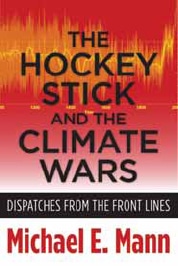 In The Hockey Stick and the Climate Wars, Michael E. Mann offers a personal assessment of the controversies and shenanigans that have surrounded the issue of global warming during the past decade and a half. The “hockey stick” refers to a famous graph, produced by the author and others in 1998 and refined in 1999, that shows the average global temperature during the past 1,000 years spiking upward in the late 20th century, exceeding the levels reached during the Medieval Warm Period. The “climate wars” that followed were largely generated by globalwarming deniers, who sought to discredit not only Mann’s graph but also the scientific foundations on which it rested. Considering the hostile rhetoric of climate-change skeptics and the personal threats leveled against the author and his colleagues, the military analogy is apt. As Mann notes, the late “right-wing provocateur Andrew Breitbart had ‘tweeted’: ‘Capital punishment for Dr. James Hanson. Climategate is high treason.’”
In The Hockey Stick and the Climate Wars, Michael E. Mann offers a personal assessment of the controversies and shenanigans that have surrounded the issue of global warming during the past decade and a half. The “hockey stick” refers to a famous graph, produced by the author and others in 1998 and refined in 1999, that shows the average global temperature during the past 1,000 years spiking upward in the late 20th century, exceeding the levels reached during the Medieval Warm Period. The “climate wars” that followed were largely generated by globalwarming deniers, who sought to discredit not only Mann’s graph but also the scientific foundations on which it rested. Considering the hostile rhetoric of climate-change skeptics and the personal threats leveled against the author and his colleagues, the military analogy is apt. As Mann notes, the late “right-wing provocateur Andrew Breitbart had ‘tweeted’: ‘Capital punishment for Dr. James Hanson. Climategate is high treason.’” How much things may have improved in the wake of these efforts is unclear. The 2011 Transparency International (TI) Bribe Payers Index, which ranks both countries and sectors by the likelihood of paying bribes to gain overseas business, ranks the arms, defense, and military sector 10th, a significant improvement from earlier surveys. Earlier TI research cited by Feinstein, however, concluded that the arms trade was “hard-wired for corruption” and accounted for 40% of all corruption in global trade.
How much things may have improved in the wake of these efforts is unclear. The 2011 Transparency International (TI) Bribe Payers Index, which ranks both countries and sectors by the likelihood of paying bribes to gain overseas business, ranks the arms, defense, and military sector 10th, a significant improvement from earlier surveys. Earlier TI research cited by Feinstein, however, concluded that the arms trade was “hard-wired for corruption” and accounted for 40% of all corruption in global trade.

